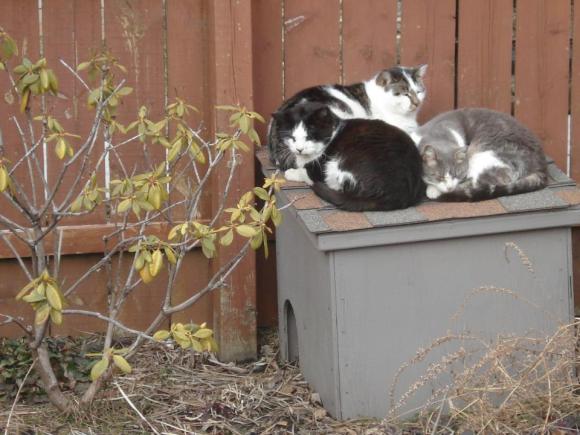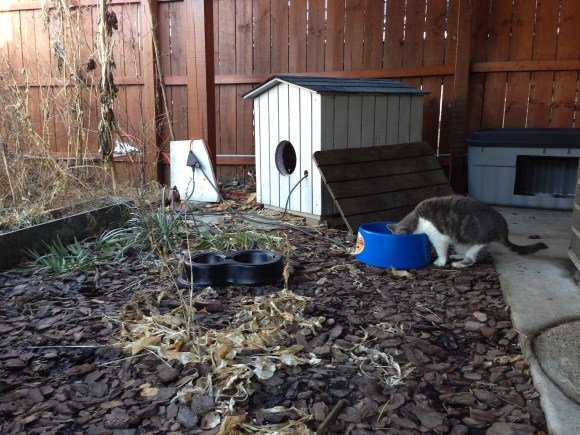There is a lot of invested time, effort and money needed to help the feral cat colonies. But I wanted to share the numbers here to show what can be done, that it’s not impossible, and to thank all of you again so much for your support. Also, I know there are people out there who do so much, and I really encourage everyone to broadcast their rescue work. People do amazing things, and their stories can also inspire others to help more animals.
So, here’s a look at 2014, a year in review, if you will:
Colony medical costs were $2,767.37, for seven cats that I found sick outside.
Cat food and supplies cost $1,579.69
Thank you again to Barb G., Ben M. and Carolyn T., Carlin R. and Kathy M., Dorota Z., Elisa G., Erica R. and Rob J., Greer G., Heather F., Joyce K., Kristina R. and her mom, Linda R., Liz H., Lora M., Niuris R. and family, Rachel and Nick K., Rhodri K., Rob and Candice C., Zac and Beth N. Your Paypal donations totaled $1398.79
Thanks to Janessa and Forget Me Knodt for teaming up on the Feral Flowers Project and selling the flowers I grew in my garden last summer, and for hosting a Feral Flowers Design and TNR Class. Together we raised $1,181.50, and also raised a lot of awareness for the outdoor cats.
Thanks to my friend and bandmate, Julia B., for hosting a Halloween show of rock music, called Feral Fete, performed by my amazing, animal-loving friends, and donating all proceeds, $702, to Cats In My Yard.
Without donations and fundraising, this would have been so much harder. In total, as of the end of 2014, 177 cats were TNR’d in 20 locations within one square mile here since 2007. There are now 59 cats remaining outside. The other cats were either adopted out, died, or disappeared.
And sometimes the remaining ones get sick, especially now that the colony cats are aging. I believe all animals’ lives matter, whether they are feral or not, and will try to provide any medical care necessary. I want to thank North Center Animal Hospital, Roscoe Village Animal Hospital, and Village West Veterinary for their help, care and compassion in treating cats in traps.
Here’s another look at the cats that your donations and support helped with last year. Please note that some of these images may be distressing to look at.
Munkimo
Munkimo from the Mother Colony showed up at his feeder’s house in obvious distress during a winter storm last February. He was cold, wet, shivering, and there was blood on his back. I easily placed him in a trap and took him for multiple vet visits. His bills totaled $309.55 Munkimo tested FIV+, but he was sick because of an infected bite wound and upper respiratory infection, URI. The skin just peeled off of his back. He had a fever, and his paw pads were black with frostbite. After being crated in my house and treated with antibiotics, he bounced back within a few weeks. But I had to keep him inside crated for almost two months because this was during the Polar Vortex and he still needed the hair on his back to grow. He has been doing fine ever since I returned him.
Zombie Cat
Zombie Cat from the V Colony had sores behind her ears, disheveled fur, labored breathing, and a chronic URI. I trapped her and brought her in for multiple vet visits. She had several rounds of antibiotics and a dental. Her medical bills totaled $518.22 She stayed with me for two months in Feral Cat Recovery Lounge donated to me by Dave H. During this same time it got stressful because I was also treating another feral cat for URI (Sneezy), and then another cat (Wally) came in sick that I ended up treating and fostering because he was also friendly. And I had a planned vacation during this. But it worked out, and even though Zombie Cat still gets sick with URI, she is much better. And definitely doing better outside.
Sneezy
Sneezy from the V Colony was just with me for a week in a recovery Tru-catch trap. He was treated with antibiotics that just cost $10 for his chronic URI. Sneezy was absolutely terrified the entire time, so confinement is extra stressful for him. I had to weigh the stress of that against his overall well-being. He still gets a bit sick outside, and sleeps a lot, but is doing better.
Wally
Wally also showed up sick in the V Colony a few weeks after his TNR. He turned out to be incredibly friendly, so I ended up fostering him for two months while he was being treated for haemobartonella and taking him to the vet. His medical bills totaled $326.42 He made a full recovery and was adopted by my good friends Carlin and Kathy in St Louis.
Billy Idol
Billy Idol from the V Colony showed up sick while I was fostering Wally. His head was tilted to the side, he meowed nonstop, his eyes were red and had discharge, and he walked in circles. The vet determined that he was suffering possibly from toxoplasmosis and a URI. His medical bills totaled $257.05 Thankfully his feeders were able to treat Billy in a recovery trap for a week with antibiotics and medication. Billy seemed to get better and they let him back out into the colony because he was stressed from the confinement. So far ever since he seems to be doing well.
Dice
Dice is from my colony, the James’ Gang Colony, and he got really sick last year. In the spring I trapped and took him to the vet where he was treated for URI, stomatitis, and had 10 teeth pulled with his dental. This seemed to buy him some time, but he was sick again in the fall. He showed up one day and just laid in my yard. He was down to four pounds and the vet thought perhaps he was going into kidney failure. His medical bills totaled $860.03 Also, confinement was incredibly stressful for Dice. He would only eat, and could barely move. Ultimately, after a few days, he was humanely euthanized at the vet’s office. RIP, Dice. My heart still breaks when I think of him. The last photo is from back when he was a healthy, TNR’d colony cat.
Woodrow Whiskers
Woodrow Whiskers from the La Vida Lydia Colony disappeared and then showed up sick at his feeder’s house. She took him in, and he was docile and clearly in distress. He would urinate sporadically. I took him for multiple vet visits where they treated his bladder, did blood tests, and determined he most likely has cystitis. His medical bills totaled $486 He made a full recovery with the antibiotics and medications. He showed his friendly side once he was indoors, so was admitted to a no-kill shelter for adoption.
I’ve got my eye on a few cats I’m concerned about out there, and am busy with the colony cats that decided to show their friendly side. And I have plans to help TNR colonies for other feeders. Onward to 2015!
















































































Poor kitty. It is sad that people just leave their pets behind like that. I’m glad that he was fortunate enough to show up on your street where he can be cared for at least. Thank you for caring for the strays/ferals!
Thank you, Robin! Another neighbor told me she saw him as well. We are watching out for him.
It’s very sweet of you to create that outdoor shelter for him
It’s crazy how people can just leave cats just like that!
Thank you for looking after him